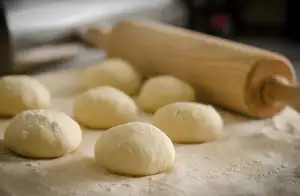Flour 101: Unlocking the Shelf Life Secrets for Perfect Recipes

Flour is a staple ingredient in many recipes, from bread and pastries to sauces and gravies. But have you ever wondered how long flour can be stored before it goes bad? Understanding the shelf life of flour is crucial for maintaining its freshness and ensuring the success of your culinary endeavors. In this article, we will delve into the factors that affect the shelf life of flour, explore different types of flour and their respective shelf lives, discuss proper storage techniques, identify signs of spoiled flour, and answer some frequently asked questions. So let's unlock the secrets to extending the shelf life of your flour and make every recipe a flavorful success!
Factors Affecting the Shelf Life of Flour
The shelf life of flour can vary depending on several factors. One important factor is the type of flour. Whole wheat flour, for example, has a shorter shelf life compared to all-purpose flour due to its higher oil content. Another factor is the presence of moisture. Flour absorbs moisture easily, which can lead to spoilage and the growth of mold or bacteria. The storage conditions also play a crucial role in determining the shelf life of flour. Exposure to heat, light, and air can accelerate the deterioration process. Additionally, insects and pests can infest flour if not stored properly. It's essential to consider these factors to ensure that your flour stays fresh for longer periods.
Types of Flour and Their Shelf Life
There are various types of flour available in the market, and each type has a different shelf life. All-purpose flour, which is commonly used in baking, has a shelf life of about 6 to 8 months when stored properly. Whole wheat flour, due to its higher oil content, has a shorter shelf life of around 4 to 6 months. Self-rising flour, which contains baking powder and salt, can last for about 4 to 6 months as well. Specialty flours like almond flour or coconut flour have a shorter shelf life of approximately 3 to 4 months. It's important to note that these are just general guidelines, and the actual shelf life may vary depending on storage conditions and brand recommendations. Always check the expiration date on the packaging for more accurate information.
Proper Storage Techniques for Extending Flour's Shelf Life
Proper storage techniques play a crucial role in extending the shelf life of flour. Here are some tips to help you keep your flour fresh for longer:
1. Store in airtight containers: Transfer your flour into airtight containers such as glass jars or plastic containers with tight-fitting lids. This will prevent moisture and pests from getting into the flour, which can lead to spoilage.
2. Keep away from heat and light: Flour should be stored in a cool, dry place away from direct sunlight and sources of heat. Exposure to heat and light can cause the flour to go rancid more quickly.
3. Avoid storing near strong odors: Flour has the tendency to absorb odors, so it's important to keep it away from strong-smelling foods like spices or cleaning products. This will help maintain the flavor and quality of the flour.
4. Use within recommended timeframes: Different types of flour have varying shelf lives, so it's essential to use them within their recommended timeframes. All-purpose flour typically lasts for about 6-8 months, while whole wheat flour has a shorter shelf life of around 4-6 months.
5. Consider refrigeration or freezing: If you live in a hot and humid climate or want to extend the shelf life even further, you can consider refrigerating or freezing your flour. Just make sure to use airtight containers and allow the flour to come back to room temperature before using it.
By following these proper storage techniques, you can maximize the shelf life of your flour and ensure that it remains fresh for all your baking needs.
Signs of Spoiled Flour and When to Discard
It is important to be able to recognize the signs of spoiled flour to ensure the safety and quality of your recipes. Here are some common indicators that your flour has gone bad:
1. Off smell: Fresh flour should have a mild, slightly sweet aroma. If you notice any unpleasant or rancid smell, it is a clear sign that the flour has spoiled.
2. Mold growth: Check for any visible mold on the surface of the flour. Mold can appear as green, black, or white spots. If you see any mold, discard the entire batch immediately.
3. Strange texture: Good flour should have a smooth and uniform texture. If you notice clumps, lumps, or any unusual texture, it could be a sign of moisture absorption or contamination.
4. Pest infestation: Insects such as weevils or beetles can find their way into improperly stored flour. If you spot any bugs in your flour, it's time to throw it away.
When it comes to determining when to discard your flour, it's better to err on the side of caution. Even if there are no obvious signs of spoilage, if your flour has been sitting in your pantry for an extended period (beyond its recommended shelf life), it is best to dispose of it.
Remember that consuming spoiled flour can lead to foodborne illnesses and affect the taste and quality of your dishes. So always prioritize freshness and safety when using flour in your culinary endeavors.
Frequently Asked Questions about Flour's Shelf Life
1. How long does flour typically last?
The shelf life of flour varies depending on the type. All-purpose and bread flours can last up to 1 year if stored properly, while whole wheat and gluten-free flours have a shorter shelf life of around 6 months.
2. Can I use expired flour?
Expired flour may not necessarily be harmful, but it can affect the quality of your baked goods. It's best to discard flour that is past its expiration date for optimal results.
3. Does storing flour in the freezer extend its shelf life?
Yes, storing flour in the freezer can extend its shelf life by up to 2 years. Make sure to store it in an airtight container or resealable bag to prevent moisture absorption.
4. Can I still use flour with small insects or weevils?
It is not recommended to use flour with insects or weevils as they can contaminate your food and cause health issues. Discard any infested flour immediately.
5. How can I tell if my flour has gone bad?
Spoiled flour may develop a rancid smell, change in color, or show signs of mold growth. If you notice any of these signs, it's best to discard the flour.
6. Can I mix different types of flours for longer shelf life?
Mixing different types of flours does not necessarily extend their individual shelf lives. Each type should be stored separately according to their specific storage requirements.
Remember, proper storage techniques are crucial for maintaining the freshness and quality of your flour, ensuring delicious results every time you bake!
By understanding the factors that affect the shelf life of flour and implementing proper storage techniques, you can maximize its longevity and ensure that your recipes turn out perfectly every time. Remember to store your flour in a cool, dry place away from moisture, heat, and light. Use airtight containers or resealable bags to prevent exposure to air and pests. Regularly check for signs of spoilage such as off odors or discoloration, and discard any flour that is past its prime.
With these tips in mind, you can confidently stock up on different types of flour without worrying about them going bad too soon. Enjoy the convenience and versatility of having a well-stocked pantry, knowing that your flour will be ready to use whenever you need it. So go ahead and embark on your flavorful food adventure with the assurance that your flour is fresh and ready to create culinary delights!
Published: 03. 02. 2024
Category: Recipes



